- Smurfit Kappa Cartón de Colombia (SKCC), a paper company with multiple plantations certified by the FSC ethical wood label, is facing backlash from Indigenous and local farmers over land disputes and environmental impacts.
- Mongabay was able to confirm three cases of plantations violating Colombia’s legal forest code. Communities living close to the company’s paper plantations say they are to blame for water shortages and a decrease in biodiversity and soil fertility.
- There is little agreement over the effects of these plantations on water availability, but many activists and academics say agroforestry or silvopasture systems can be alternative solutions to increase biodiversity and contribute to farmers’ livelihoods.
- A SKCC forestry division manager said SKCC carries out rigorous legal and background analyzes of the properties to operate according to the law and practices respect for the environment.
CAJIBIO, Colombia – From a birds-eye view, greenery expands far into the tropical Andean horizon in Colombia’s department of Cauca, easily confused with a sprawling native forest. However, for the Indigenous Misak communities and farmers living in the region, they know that this is far from a native forest – it is a tree plantation owned by one of Colombia’s largest paper producing companies.
Smurfit Kappa Cartón de Colombia (SKCC), subsidiary of Irish multinational Smurfit Kappa Group, is a leading producer of paper and cardboard products in the country. Operating in the nation since 1986, Colombia is one of the global giant’s six most important sites. Products are derived from pine trees such as patula pine (pinus patula) and rose gum trees (eucalyptus grandis), species foreign to the region. Plantations are located in six Colombian departments, totaling 70,000 hectares (172,973 acres).
The department of Cauca is of great importance to the company, holding about a third of its national plantations, with 3,000 hectares (7,413 acres) found in the town of Cajibio. This plantation is certified by the Forest Stewardship Council (FSC), an ethical wood label that promotes the responsible management of forests.
However, SKCC has attracted the ire of most Indigenous Misak and local community members in Cajibio who accuse the company of land grabs. Community leaders have found the plantation to be defying Colombia’s legal forest code and say it is diminishing access to water.
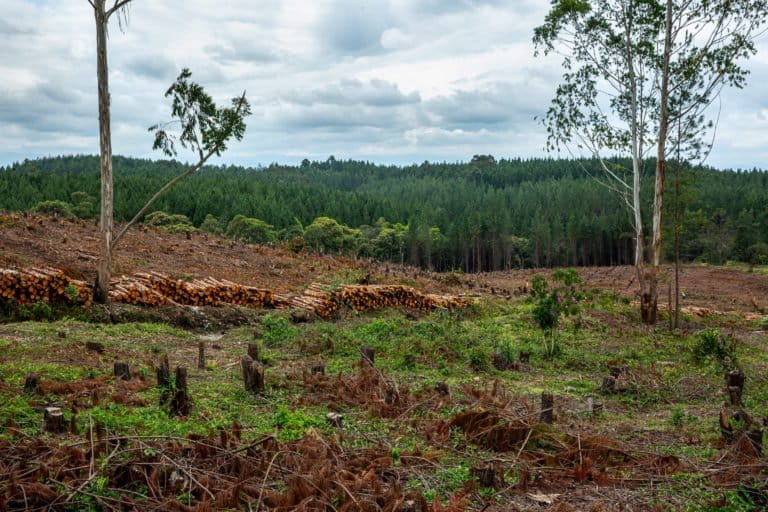
They are asking the National Land Agency and ministry of agriculture to honor the 2016 peace treaty, which promises to redistribute the land back to Indigenous, Afro-Colombian and rural communities affected by Colombia’s 50-year armed conflict, and grant them ownership to the land. About 55% of households lost access to their land during the conflict. Local leaders argue land redistribution is considerably behind schedule.
“They will not be able to throw us out of here easily, we are set in stone on the rights of our grandparents […] this is our land,” said a leader of the Misak Indigenous community.
The multinational company denies all accusations of land grabs and malpractice. Some local residents are in favor of the SKCC plantations for creating employment opportunities in the rural area.
“Before consolidating processes such as the purchase of land, we carry out rigorous legal and background analyzes of the properties to ensure that everything is under the criteria of the law,” Nicolás Pombo, forestry division manager at SKCC, told Mongabay.
In July last year, Indigenous and local farmers occupied the company’s plantations in protest and cut down and damaged about 1,000 hectares (2,471 acres) of pine and rose gum trees. They replaced them with food crops and set up a camp on the edge of the plantations. Further actions took place on May 8, when they began uprooting newly planted trees.


“This land belonged to Leonidas Paz, and my parents and uncles used to plant food in association with them. He would give the land, the seeds, and my family offered the manpower as well as part of the agricultural supplies,” said Juan Calambas, a member of the Misak community living close to the plantations, who asked not to use his real name for safety reasons. During last year’s protests, locals report that they were attacked by SKCC’s workers, with one arrested by armed forces when driving home.
The Misak used to inhabit the lowlands of the Cauca region but when Spanish colonists arrived, the community was pushed to the mountains around 40 kilometers (about 25 miles) away from Cajibio. After numerous land struggles, they settled in the Guambia reservation, where most of its 23,000 population live.
Due to lack of sufficient productive land for everyone, other Misak settlements went to re-established themselves in the lowlands. In Cajibio, two of these settlements, totaling 110 Misak families, are next to SKCC’s forest plantations.
“Here a family of eight or ten survives from growing food on one or two hectares [2.5 to 5 acres], but this is not enough,” said a leader of the Laguna Misak Council, a settlement close to SKCC plantations in Cajibio.
In Cajibio, the Agricultural Family Unit–the minimum required for a peasant family to subsist–is between 4 to 6 hectares (10 to 15 acres).
“We pulled out their pine trees just as they do with our corn, beans, and cassava crops [in the plantations],” said David Yalanda, a Misak farmer.
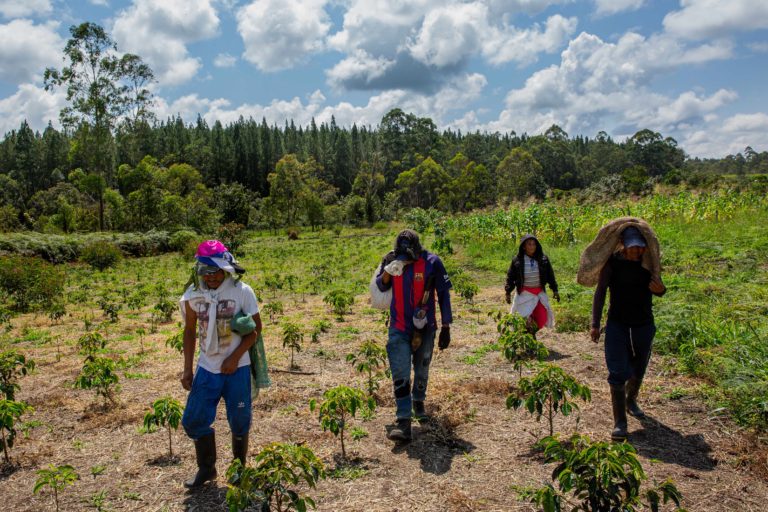
Controversy with a FSC certification
In 2017, the multinational was ordered to restitute 78 hectares (193 acres) of land to the Rivera family located in another department, after the Land Restitution Court of Cali determined that SKCC had profited from the 50-year armed conflict by acquiring the land at a low price.
This is the only successful case of land restitution against SKCC.
Locals and activists in the Cauca department also accuse the company of paying unfairly low prices for the land in their region. SKCC is included in the Institute for Development and Peace (INDEPAZ), a Colombian human rights NGO, list of foreign companies that contribute to unequal access of land in the country.
SKCC’s paper products in Cauca hold an FSC 100% label for meeting “rigorous social and environmental standards” audited by an independent third party. Last year, FSC came under fire from NGOs for systematic flaws that allow companies with questionable environmental and human rights records to benefit from certification.
In the case of Cauca, Misak and local farmers say they are facing depleting water sources due to the high volume of water consumed by plantations.
According to Colombian law, pine and eucalyptus trees should be planted at least 30 meters (about 100 feet) away from water basins to protect the resource. Yet, during visits to Smurfit Kappa’s plantations in Cauca, Mongabay was able to verify three cases of trees planted next to water streams, this included the use of pesticides during the rainy season. This increases the probability of contaminating water sources, locals complain.
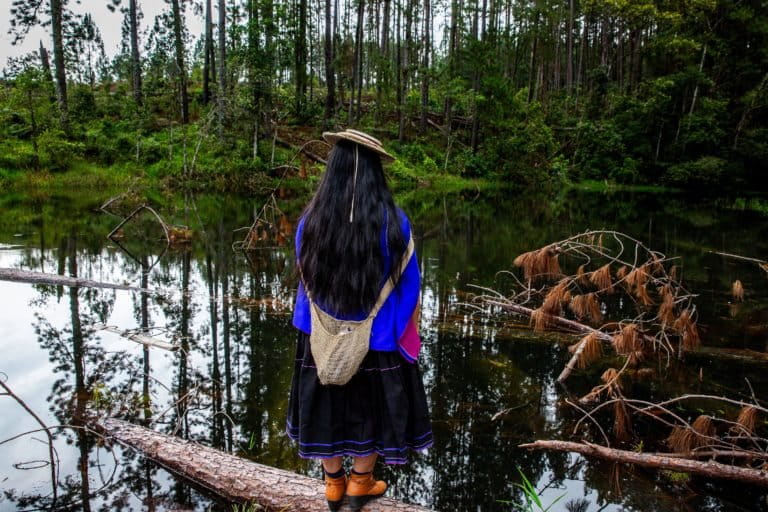
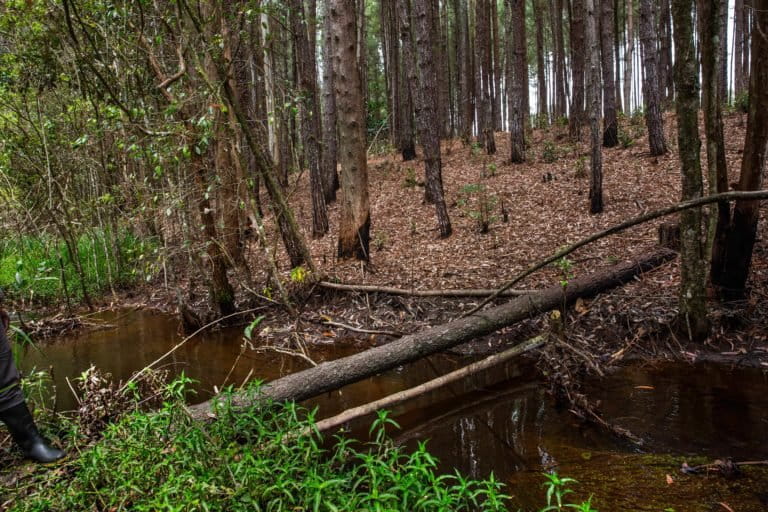
“The issue is that this [monoculture] model expels communities from their territory and destroys their ecosystems,” said Diego Cardona, coordinator of forests and biodiversity at CENSAT Agua Viva, in an interview for Mongabay.
Rural inhabitants living close to SKCC’s plantations rely partially on wells and artisanal water pump systems, as the rural aqueduct does not satisfy the community’s necessities. Many told Mongabay about their difficulties in accessing enough water during the dry season due to a depletion of the resource in underground aquifers.
“We have seen a reduction in the water flows caused by pine trees year after year. There is no respect for our water sources as eucalyptus trees are planted right next to the water’s eyes. The issue is very critical,” said Taita (Misak leader) Jairo Tunubala, who asked us not to use his real name for his safety.
However, studies to examine the reduction of underground water levels due to the plantation have not yet been conducted.
Professor Guillermo Vasquez, an expert in forest hydrology at the National University of Colombia, disputes the notion that plantations of these species always deteriorate water sources. He admits, however, that “In a natural forest, [hydrology is] much better. It is of higher quantity and has good regulation and excellent quality.” Following a study, Vasquez found that monoculture forest plantations consume 15% more superficial water than a natural forest.
Pombo told Mongabay that SKCC only used herbicides during the first two years of setting the plantation and according to the requirements by the law. He did not specify which herbicides were used. He added that SKCC activities are carried out responsibly and water resources are managed adequately.


Conservationists and locals also raise the alarm of the environmental impacts plantations are having on the region’s biodiversity and the quality of soil.
“[These plantations] are very sterile places. I have taken samples in pine forests in the Andean region and I did not find even one species of frog […] in general, they avoid going in there due to the acidity in the soil and the leaf litter,” explains Nicolás Urbina, a specialist on biodiversity and conservation at the Javeriana University.
“If you see a native eucalyptus forest in Australia or a native pine forest in Mexico or the United States, there are many bushes and other species that provide food for birds and omnivores in general. But on a plantation, there is nothing, it is a desert,” Urbina explained.
One of the frogs that is highly threatened in the areas where SKCC operates, is the Cauca poison frog (Andinobates bombetes), an endemic species to Colombia. Currently, the Andean region is facing a 75% rate of deforestation in its natural forests.
“If you walk around the plantation, you cannot hear any birds. But where I live, you can see many types that arrive every day. That is why we want Cartón de Colombia out. So that the birds come back”, said Tunubala.
The Food and Agriculture Organization (FAO) has labeled monoculture plantations as ‘planted forests.’ A term that has generated disagreement among environmentalist organizations.
“To say that a plantation is a forest, is like saying that an aquarium is an ocean,” said Cardona of CENSAT Agua Viva.
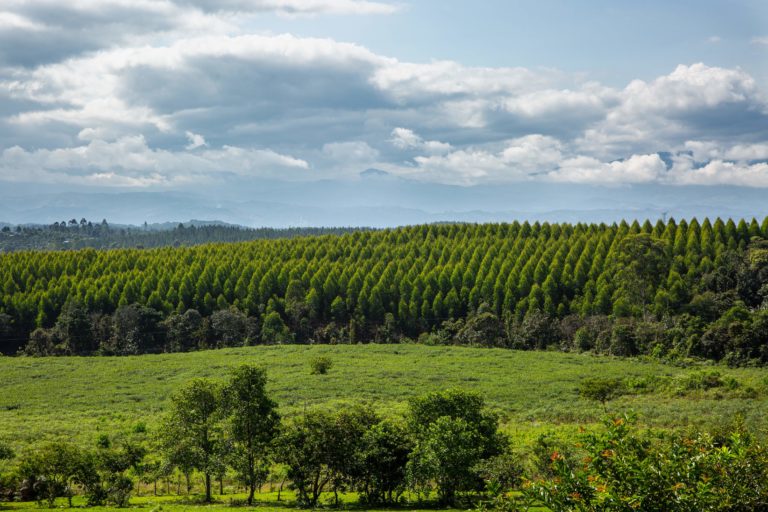
Cardona recalled the most controversial case of tropical deforestation associated with SKCC that took place in Bajo Calima – located on the pacific coast, north of the Cauca region – for more than 30 years.
“In Bajo Calima the ecosystem was destroyed for years through clear-cutting practices. That means using a chain tied to two tractors and sweeping away everything, including animals,” he explained.
Benefits, incentives and changes
Although communities living close to the plantations criticize the environmental effects caused by SKCC, some local residents celebrate the presence of the multinational in a rural area where employment is low. In 2018, SKCC generated 2,613 jobs in the country.
“Cartón de Colombia gives education, repairs roads, and employs people. That is the only company that offers employment around here,” explained Osvaldo Yánez, a previous employee of SKCC and a local in Cajibio.
“Since the beginning of our operations, at Smurfit Kappa, we have believed in, and practiced respect for the environment in the areas where we have the privilege of operating,” Pombo said.
SKCC manages around 22,000 hectares (54,363 acres) of natural forests in the country as part of a conservation effort mostly paid by the Colombian government. Through the Certificate of Forestry Incentive (CIF), aimed at promoting investment in the agroforest business, the government covers not only 75% of the costs to preserve these natural forests, but also half the costs of establishing a plantation and maintaining it during the first five years.

Environmentalists argue these incentives are concentrated in the hands of big companies like SKCC and benefit more the company’s income than the environment. In 2021, SKCC reported around $29 million profit in Colombia.
“I believe incentives could be implemented differently. The CIF has three categories: to reforest, conserve, and for commercial purposes. In practice, however, those resources are only handed over to commercial plantations and are concentrated in the hands of few companies like Smurfit Cartón de Colombia,” Cardona said.
Despite different perspectives regarding forest plantations, the land deficit in Cauca –and Colombia in general–, drives academics and activists to advocate for a shift in the forest model. Indigenous people and locals against the plantations are advocating for a communitarian management model of forests and territories as an initiative for protection.
“Replacing unproductive areas with systems of agroforestry or silvopasture could benefit communities and the environment,” said professor Jorge Ramirez, forest engineer at the Cauca University. “Planting and planting more trees would be very easy, but people do not eat wood.”
Banner image: Misak women, men and children observe the contrast between the monoculture pine and eucalyptus plantation, on the right, and the natural forest in their territory, on the left, from a distance. Image courtesy of Antonio Cascio.
Related listening from Mongabay’s podcast: We look at the major forest and conservation trends coming out of 2021 and 2022 with Mongabay founder and CEO Rhett Butler, and IUCN senior program officer, Swati Hingorani. Listen here:
FEEDBACK: Use this form to send a message to the author of this post. If you want to post a public comment, you can do that at the bottom of the page.
